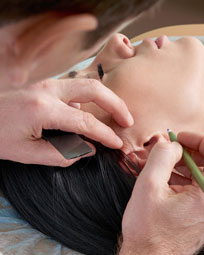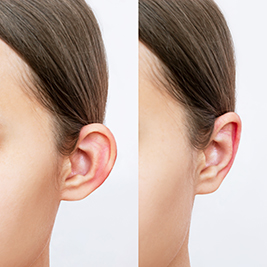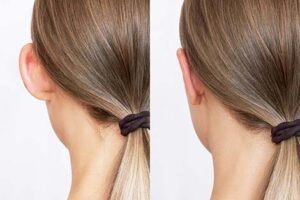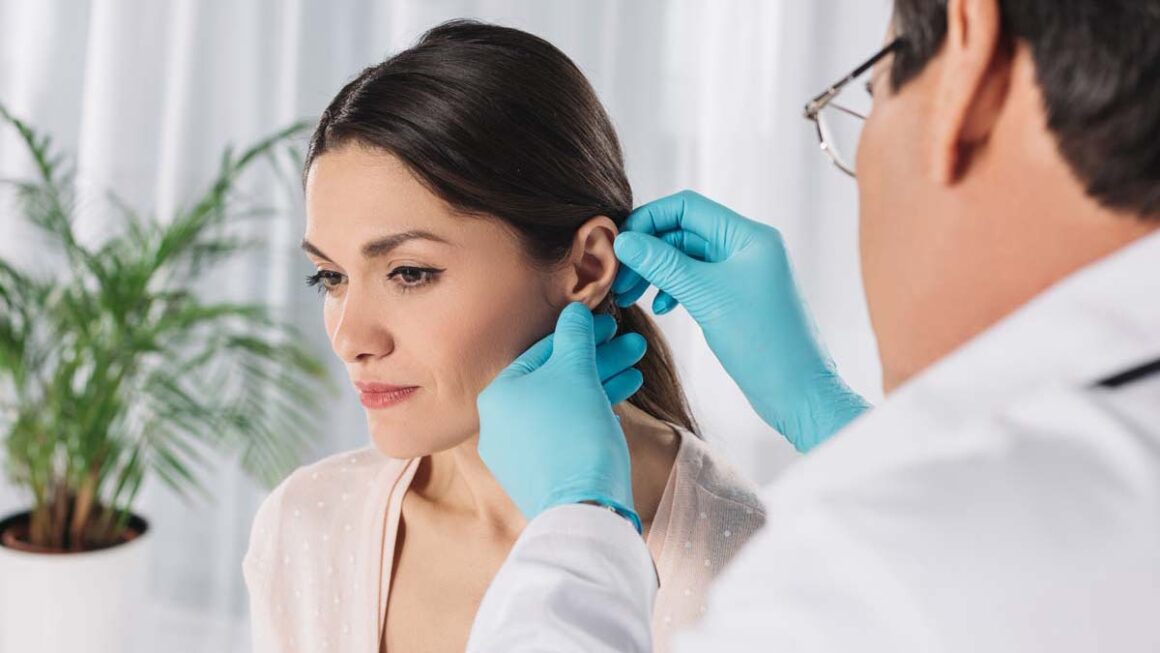Cosmetic ear surgery, also known as ‘Otoplasty’, is a type of plastic surgery performed to change the shape, position or size of the ears. It can be performed in order to correct ear deformities due to injuries or birth defects, and also sometimes to change the aesthetic appearance of the ears if the person is unhappy about the way their ears look. The aim of cosmetic ear surgery is to give the ears and face a balanced, proportional and more natural appearance. Even the correction of minor deformities in the ear can contribute greatly to the appearance and self-esteem of the person.
Cosmetic ear surgeries are performed on the visible part of the outer ear called the ‘auricle’. The auricle consists of cartilage folds covered with skin. It begins to develop in the womb and continues to develop in the years after birth.
There are several types of cosmetic ear surgeries:
• Ear Augmentation : Sometimes the ear may be underdeveloped or small. In these cases, it may be desirable to enlarge the outer ears.
• Ear Pinning : In cases where the ears have a prominent appearance, this surgery aims to bring the ears closer to the head.
• Ear Reduction : In cases where the ears are larger than normal, this type of surgery is made to reduce the size of the ears.
Cosmetic ear surgeries are not operations done for functional problems. They neither change the person’s ability to hear nor the location of the ears.
What is cosmetic ear surgery (otoplasty)?
Operations performed to change the shape, position or size of the ears are called ‘Cosmetic Ear Surgery’ (Otoplasty).

What does cosmetic ear surgery treat?
- Overly large ears
- One- or two-sided prominent ears
- Asymmetrical ears
- Small-sized ears as a birth defect
- Trauma-related ear deformities
How is ear plastic surgery performed?
There are 3 types of cosmetic ear surgery. Ear reduction is performed when the ears are large, ear enlargement is performed for small ears, and ear pinning is performed for prominent ears. Cosmetic ear surgery is typically performed on both ears to ensure symmetry.
Am I a good candidate for cosmetic ear surgery?
If you have asymmetrical looking ears, if you are not satisfied with the size of your ears and/or the position of your ears, if you have a birth defect, if you have a deformity due to trauma, if you do not have medical problems which are life-threatening or that will adversely affect wound healing, you can have cosmetic ear surgery.
Especially for children who will undergo surgery, it is preferable that they are healthy, do not have any life-threatening diseases or untreated chronic ear infections, and have the perception to understand what is being said and follow instructions well.
Is there an age limit for ear plastic surgery?
After the ears reach their full size, which is usually after the age of 5, ear aesthetics can be performed at any age until adulthood.
What are the risks of ear plastic surgery?
As in all surgical applications, complications such as bleeding, infection and anesthesia may also occur after cosmetic ear surgery.
What should I do before cosmetic ear surgery?
• Medications: It is recommended to avoid aspirin, anti-inflammatory drugs and herbal supplements that can increase bleeding.
• Smoking and alcohol: It is recommended to stop smoking and alcohol use one week before the surgery.
Step-by-step surgery process
Anesthesia: Local or general anesthesia
Surgical procedure: The surgery is performed with the technique which your physician deems appropriate for your condition.
What should I expect after cosmetic ear surgery?
After the surgery, your ears will be covered with bandages for protection and support. It is very important for the success of the surgery that the bandages are not moved. These bandages will stay on for at least 3 days. You may feel some discomfort and itching after the surgery. Painkillers should be taken as recommended by your physician.
What should I pay attention to after cosmetic ear surgery?
You should avoid sleeping on your side to avoid pressure on your ears. You should also try not to rub the wound sites or apply excessive force. It may be more comfortable to wear shirts with buttons or loose collars. During the healing process, it is important that the surgical incisions are not exposed to excessive force, sunlight or solarium light, abrasion or movement.
 How long should I rest after ear plastic surgery?
How long should I rest after ear plastic surgery?
Resting at home for 4 days after the surgery is sufficient.
How long after ear plastic surgery can I return to work?
You can return to work after 4-5 days.
What is the recovery time for cosmetic ear surgery?
Your bandages are removed 3 days after surgery. Swelling and redness in the ears will probably persist to a small extent. You may need to wear a loose headband that covers your ears at night for 3 weeks. This band will prevent you from pulling your ears forward when turning over in bed. The results of ear plastic surgery are permanent, but there is always the possibility of revision surgery. After a month or two, the ears will fully achieve their new shape.
Frequently Asked Questions
The prevalence of ear deformities in the population is approximately 5%. Among these, prominent ears are the most common.
Prominent ear is completely passed on to the child through the genes of the mother and father. Thus, it is inherited.
There is no change in the appearance of prominent ears with age.
There is a correction surgery for prominent ears within cosmetic ear surgery.
With ear pinning surgery (pinnaplasty), which is performed from behind the ear, the dislocated outer ear cartilage is brought closer to the bones of the head.
Cosmetic ear surgerys can be performed after the age of 5. The most common age group is between the ages of 7 and 14 because it is much more possible for them to understand and follow the doctor’s instructions.
Prominent ears surgery can be performed at the age of 5 at the earliest, because the ears have completed 90% of their development at this age. Correction of prominent ears in preschool age could prevent potential psychological problems that the child might experience at school.
Of course you can have otoplasty at the age of 13.
It is impossible to correct the ear auricle without surgery.
With otoplasty, all kinds of deformities in the ears can be corrected and reconstructed.
Fixing the ears to the side wall of the head is only possible with surgery.
There are 3 types of cosmetic ear surgery. Ear reduction is performed when the ears are large, ear enlargement is performed for small ears, and ear pinning is performed for prominent ears. Cosmetic ear surgery is typically performed on both ears to achieve symmetry.
The fixing of prominent ears is permanent only with surgery.
It takes 1-2 hours depending on the type of surgery.
Local or general anesthesia is applied according to the type of surgery.
As with all surgical procedures, bleeding, infection and adverse reactions due to anesthesia are also possibilities,although infrequent, in cosmetic ear surgery.
After poorly planned surgery, there may be asymmetry or an unnatural appearance due to overcorrection.
There may be some uncomfortable pain after the surgery. This pain can be easily managed with painkillers.
The swelling due to otoplasty continues to decrease for 2-3 weeks.
The ears are wrapped with an elastic bandage after the surgery.
3 days after the operation, the elastic bandage is removed and replaced with a hair band that is not too tight for another 3 weeks.
You should avoid sleeping on your side for 2 weeks to avoid pressure on your ears. You should try not to rub the wounds or apply excessive force. Since foods that are hard and require chewing for a long time may cause pain in the first days, you should try to eat liquid food during this period. A hair band is worn to prevent the ears from folding forwards. Glasses should not be worn for 2 weeks. Smoking should be avoided for 2 weeks.
You can take a shower three days after the surgery.
You should shower with warm water. You should try not to rub the wound areas or apply excessive force.
Your ears may be traumatized while exercising. That is why you should wait 2 weeks before doing sports.
You can start exercising 2 weeks after otoplasty.
You can swim after 3 weeks. You can dive after 2-3 months.
It is not recommended to use headphones for the first month.
To avoid pressure on your ears, you should avoid sleeping on your side for 2 weeks, preferably you should on your back.
You can sleep on your side 2 weeks after ear surgery.
You can wear glasses after 2 weeks.
Full recovery takes 2 weeks.
Since self-absorbable suture material is used, there will no visible scar on the ear after 2 weeks.
The results of ear aesthetic surgery are permanent.
The corrective effect of ear aesthetic surgery is permanent. Therefore, the ears will not return to their old shape.
Otoplasty has a high success rate. It is accepted to be 95-98% successful on average.
Cosmetic ear surgery has no functional effect, it does not alter the function of hearing.
It is possible to enlarge small ears with otoplasty.
You can reduce your ears with cosmetic ear surgery.
Yes, it can. With cosmetic ear surgery, you can reduce your oversized ears.
With ear aesthetic surgery, earlobes can be reduced in size and any deformities can be corrected.
You get get your floppy ears corrected by cosmetic ear surgery.


Leave a Reply
You must be logged in to post a comment.